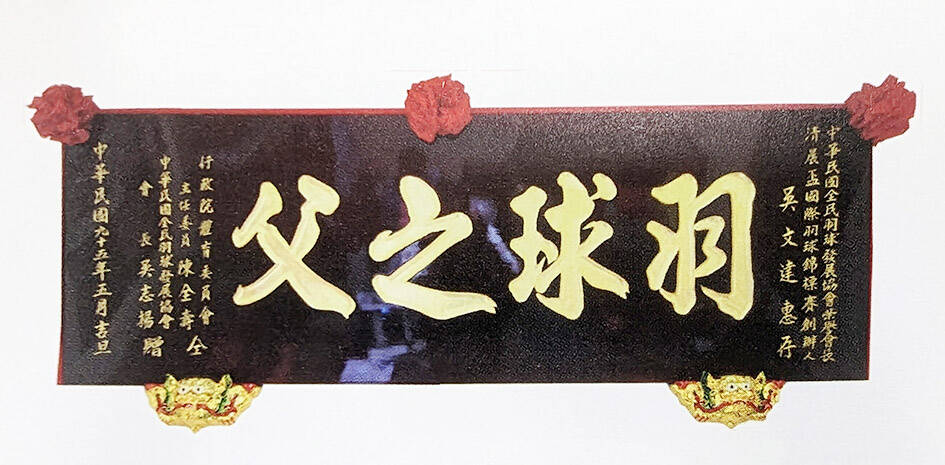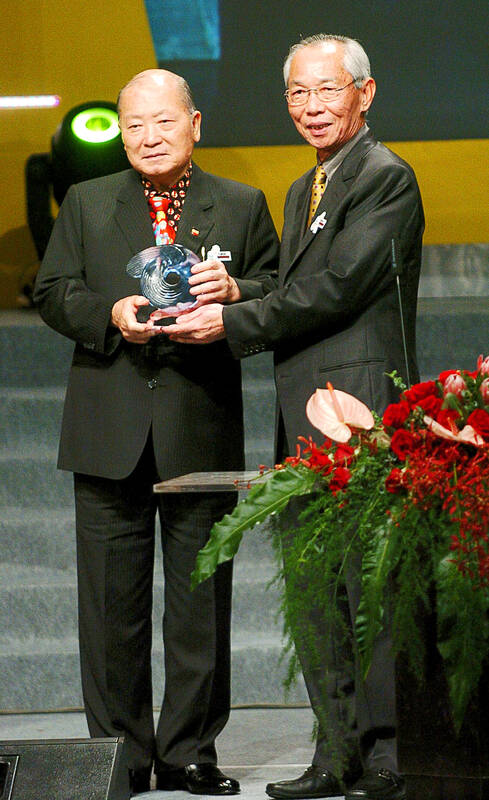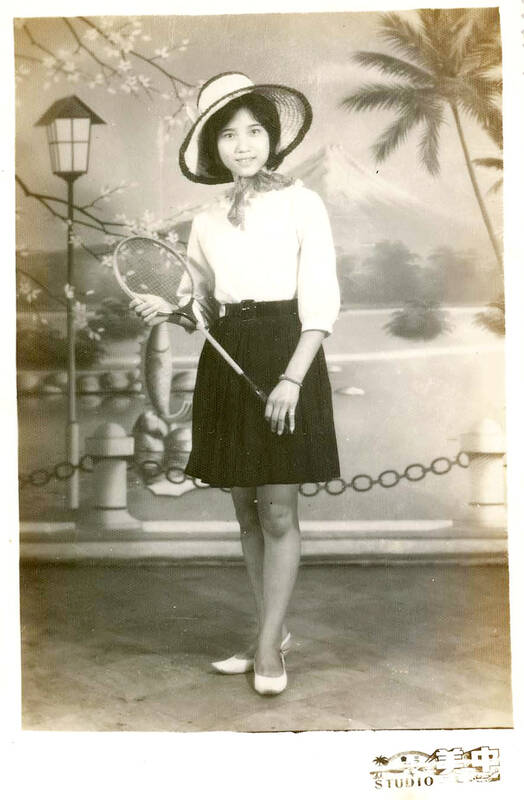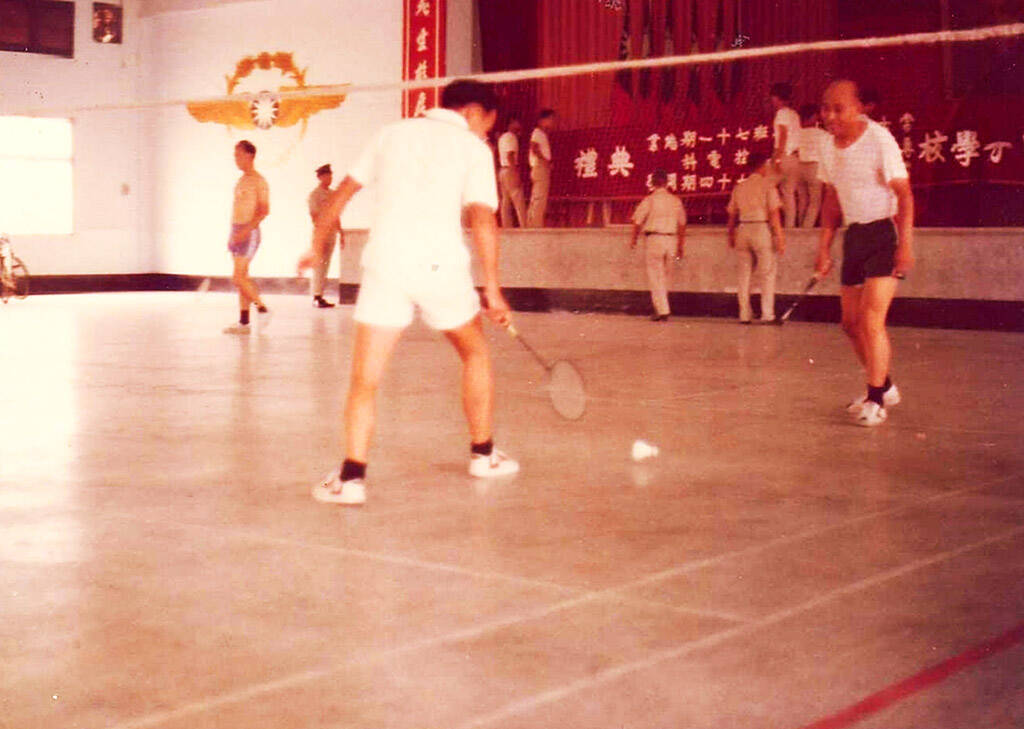Nov. 5 to Nov. 11
Wu Wen-ta (吳文達) didn’t touch a badminton racket until he was 37 years old. Once he did, however, he was hooked.
The businessman not only began playing every day, he devoted his energy and wealth to promoting the sport, and his efforts were so successful that he was officially named the nation’s “Father of Badminton” in 2006.

Photo courtesy of Taiwan Senior Badminton Association
The World Morning Cup (世界清晨盃) badminton championships, which Wu co-founded in 1972, is still running today. Beginning with just 100 local participants, this year’s event in April attracted nearly 3,600 players from across the globe. Since Wu died on Nov. 9, 2015, it’s also been known as the Wu Wen-ta Memorial Cup.
Wu did not stop at just badminton. He also helped kickstart Taiwan’s competitive canoeing and eight-person tug-of-war, and took part in developing dragon boat racing into an international event.
ATHLETIC CHILDHOOD

Photo: CNA
Wu was born in July 1929 in Taipei’s Wanhua District (萬華). A rambunctious child and natural athlete, Wu excelled in sumo wrestling, baseball, volleyball and gymnastics. According to the 2008 book Gardener of the Sporting World for Half a Century (半世紀體壇園丁), he wasn’t academically inclined, enjoying a carefree childhood playing sports and developing a competitive spirit.
Badminton did not exist in Taiwan yet; it would be introduced after 1949 by Air Force soldiers retreating from China.
Wu was a strong proponent of having students participate in sports from a young age. In the book, he disparaged the modern parental notion that children must focus solely on studying to succeed.

Photo courtesy of New Taipei City Government
At the age of 17, Wu launched his business career before he graduated high school in Keelung by selling the school’s discarded scrap metal to the mines in Jiufen. He also traded local commodities with fishermen from China.
His father and uncle taught him the ins and outs of the hardware industry and by the age of 22, Wu was running his own shop with his wife Wu-Tsai Hsiu-chen (吳蔡秀珍), focusing on steel pipes.
Wu almost lost everything after being swindled out of a major deal five years later, but he drew from his days playing sports and refused to give up. He relaunched his empire immediately and caught on to Taiwan’s industrial boom, finding new clients in cement, fertilizer and telecommunications. By the early 1960s, he was Taiwan’s undisputed steel pipe king.

Photo courtesy of Gangshan Military Dependents Village
DISCOVERING BADMINTON
As Wu’s business grew, so did his desire to get back into sports. In 1967, Cheng Yuan Junior High School (成淵國中), which his son attended, opened its athletic facilities to early morning exercisers. He immediately started the Cheng Yuan Early Risers Club, which consisted of about 30 people, including his entire family.
That year, Wu met Lin Yu-shan (林玉山), a bank employee and badminton enthusiast who spent nearly all his free time playing the game and teaching people at no cost. Lin became Wu’s mentor and his regular doubles partner, and the two dominated local competition until Lin’s untimely death at the age of 49.

Photo courtesy of Taiwan Senior Badminton Association
“I was able to maintain a high level of interest because we won so often,” Wu recalls. “In time, I became addicted. It is a habit that I could not live without.”
In 1969, Wu and 15 others, including Taiwan Shiseido founder Lee Chin-chih (李進枝) and Malaysian doctor and badminton coach Cheng Hsi-hsien (鄭錫賢), launched the Jen-ai Badminton Management Committee (仁愛羽球管理協會) with the goal of training young players for national competition. The group also served as a network for others who liked to play badminton in the morning, often practicing together and playing friendly matches.
Wu always partnered with his wife during mixed doubles events while wearing matching uniforms. The couple reportedly owned more than 120 identical outfits.
The committee launched the Morning Cup three years later at the Chunghwa Badminton Gym on Nanjing E Road, one of Taipei’s few facilities devoted to the sport. In 2006, Wu introduced the world’s first 3-on-3 format — a design that would allow an older player to partner with two younger people to make up for their decline in speed and agility, thus extending their playing careers.
OTHER VENTURES
In 1993, Wu mournfully watched his beloved Shengguang Badminton Court, which he built in 1981 in two of his former warehouses, get torn down due to the Keelung River rerouting project.
His subsequent failure in the early 1990s to convince the Taipei City government to preserve the Chunghwa Badminton Gym was probably the biggest sore point in his career. The structure was replaced with today’s Taipei Gymnasium.
As chairman of the national Badminton Association, Wu vigorously fought the city while the association launched protests, but he could not change their minds. He then launched a petition to build a badminton gym in the planned Park No 7 (today’s Da-an Forest Park), but the city rejected the proposal. Wu quit the position in frustration after nine years at the post.
During his tenure, Wu believed that it wasn’t just enough to get students involved; their teachers and principals also needed to be interested so they would whole-heartedly promote the sport. He sent free rackets to various schools and sent coaches to train the staff, pouring a great amount of his personal finances into providing equipment and scholarships. He supported national players financially — even allowing them to stay in his newly-built apartment complex for free — so they could focus on training.
Wu was also involved in fostering other sports. In 1991, he launched the national Canoe Association under the encouragement of former Japanese house speaker Yoshio Sakurauchi. The two had become close friends through badminton exchanges, and Sakurauchi was also president of the Asia Canoe Confederation.
However, canoes were restricted items then and difficult to import, and nobody in Taiwan knew how to make them. Wu managed to obtain some through a special permit that was very complicated to obtain and began training rowers. Meanwhile, he kept pushing the government to relax restrictions, finally getting his wish in 1995. That same year, the sport made its debut at the National Games in Kaohsiung.
According to the book, Wu also helped make dragon boat racing an international event by inviting teams from Hong Kong and Macau to compete in Taipei. The International Dragon Boat Federation was launched in June 1991 with Taiwan as a founding member.
In 1992, Wu started organizing eight-person tug-of-war teams, and became the Asia Tug of War Federation’s chairman in 2000.
Wu’s many awards include a lifetime contribution award from the International Olympics Committee and a 3rd class Order of the Rising Sun medal from the Japanese emperor.
Taiwan in Time, a column about Taiwan’s history that is published every Sunday, spotlights important or interesting events around the nation that either have anniversaries this week or are tied to current events.

That US assistance was a model for Taiwan’s spectacular development success was early recognized by policymakers and analysts. In a report to the US Congress for the fiscal year 1962, former President John F. Kennedy noted Taiwan’s “rapid economic growth,” was “producing a substantial net gain in living.” Kennedy had a stake in Taiwan’s achievements and the US’ official development assistance (ODA) in general: In September 1961, his entreaty to make the 1960s a “decade of development,” and an accompanying proposal for dedicated legislation to this end, had been formalized by congressional passage of the Foreign Assistance Act. Two

March 31 to April 6 On May 13, 1950, National Taiwan University Hospital otolaryngologist Su You-peng (蘇友鵬) was summoned to the director’s office. He thought someone had complained about him practicing the violin at night, but when he entered the room, he knew something was terribly wrong. He saw several burly men who appeared to be government secret agents, and three other resident doctors: internist Hsu Chiang (許強), dermatologist Hu Pao-chen (胡寶珍) and ophthalmologist Hu Hsin-lin (胡鑫麟). They were handcuffed, herded onto two jeeps and taken to the Secrecy Bureau (保密局) for questioning. Su was still in his doctor’s robes at

Last week the Democratic Progressive Party (DPP) said that the budget cuts voted for by the China-aligned parties in the legislature, are intended to force the DPP to hike electricity rates. The public would then blame it for the rate hike. It’s fairly clear that the first part of that is correct. Slashing the budget of state-run Taiwan Power Co (Taipower, 台電) is a move intended to cause discontent with the DPP when electricity rates go up. Taipower’s debt, NT$422.9 billion (US$12.78 billion), is one of the numerous permanent crises created by the nation’s construction-industrial state and the developmentalist mentality it

Experts say that the devastating earthquake in Myanmar on Friday was likely the strongest to hit the country in decades, with disaster modeling suggesting thousands could be dead. Automatic assessments from the US Geological Survey (USGS) said the shallow 7.7-magnitude quake northwest of the central Myanmar city of Sagaing triggered a red alert for shaking-related fatalities and economic losses. “High casualties and extensive damage are probable and the disaster is likely widespread,” it said, locating the epicentre near the central Myanmar city of Mandalay, home to more than a million people. Myanmar’s ruling junta said on Saturday morning that the number killed had